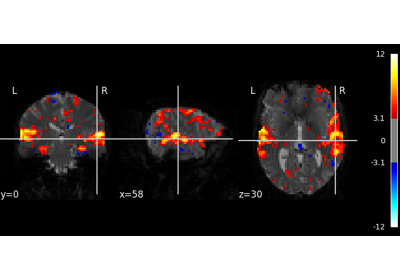Note
This page is a reference documentation. It only explains the function signature, and not how to use it. Please refer to the user guide for the big picture.
nilearn.image.clean_img¶
- nilearn.image.clean_img(imgs, runs=None, detrend=True, standardize=True, confounds=None, low_pass=None, high_pass=None, t_r=None, ensure_finite=False, mask_img=None, **kwargs)[source]¶
Improve SNR on masked fMRI signals.
This function can do several things on the input signals, in the following order:
detrend
low- and high-pass filter
remove confounds
standardize
Low-pass filtering improves specificity.
High-pass filtering should be kept small, to keep some sensitivity.
Filtering is only meaningful on evenly-sampled signals.
According to Lindquist et al. (2018), removal of confounds will be done orthogonally to temporal filters (low- and/or high-pass filters), if both are specified.
Added in Nilearn 0.2.5.
- Parameters:
- imgs4D image Niimg-like object or 2D
SurfaceImage The signals in the last dimension are filtered (see Input and output: neuroimaging data representation for a detailed description of the valid input types).
- runs
numpy.ndarray, default=``None`` Add a run level to the cleaning process. Each run will be cleaned independently. Must be a 1D array of n_samples elements.
Warning
‘runs’ replaces ‘sessions’ after release 0.10.0. Using ‘session’ will result in an error after release 0.10.0.
- detrend
bool, default=True If detrending should be applied on timeseries (before confound removal).
- standardizeany of: ‘zscore_sample’, ‘zscore’, ‘psc’, True, False or None; default=True
Strategy to standardize the signal:
'zscore_sample': The signal is z-scored. Timeseries are shifted to zero mean and scaled to unit variance. Uses sample std.'zscore': The signal is z-scored. Timeseries are shifted to zero mean and scaled to unit variance. Uses population std by calling defaultnumpy.stdwith N -ddof=0.Deprecated since Nilearn 0.10.1: This option will be removed in Nilearn version 0.14.0. Use
zscore_sampleinstead.'psc': Timeseries are shifted to zero mean value and scaled to percent signal change (as compared to original mean signal).True: The signal is z-scored (same as option zscore). Timeseries are shifted to zero mean and scaled to unit variance.Deprecated since Nilearn 0.13.0dev: In nilearn version 0.15.0,
Truewill be replaced by'zscore_sample'.False: Do not standardize the data.Deprecated since Nilearn 0.13.0dev: In nilearn version 0.15.0,
Falsewill be replaced byNone.
Deprecated since Nilearn 0.10.1: The default will be changed to
'zscore_sample'and'zscore'will be removed in in version 0.14.0.Deprecated since Nilearn 0.15.0dev: The default will be changed to
'zscore_sample'in version 0.15.0.- confounds
numpy.ndarray,strorlistof Confounds timeseries. default=None Shape must be (instant number, confound number), or just (instant number,) The number of time instants in signals and confounds must be identical (i.e. signals.shape[0] == confounds.shape[0]). If a string is provided, it is assumed to be the name of a csv file containing signals as columns, with an optional one-line header. If a list is provided, all confounds are removed from the input signal, as if all were in the same array.
- low_pass
floatorintor None, default=None Low cutoff frequency in Hertz. If specified, signals above this frequency will be filtered out. If None, no low-pass filtering will be performed.
- high_pass
floatorintor None, default=None High cutoff frequency in Hertz. If specified, signals below this frequency will be filtered out.
- t_r
float, default=None Repetition time, in second (sampling period). Set to None if not specified. Mandatory if used together with low_pass or high_pass.
- ensure_finite
bool, default=False If True, the non-finite values (NaNs and infs) found in the images will be replaced by zeros.
- mask_imgNiimg-like object or
SurfaceImage, default=None If provided, signal is only cleaned from voxels inside the mask. If mask is provided, it should have same shape and affine as imgs. If not provided, all voxels / verrices are used. See Input and output: neuroimaging data representation.
- kwargs
dict Keyword arguments to be passed to functions called within this function. Kwargs prefixed with
'clean__'will be passed toclean. Withinclean, kwargs prefixed with'butterworth__'will be passed to the Butterworth filter (i.e.,clean__butterworth__).
- imgs4D image Niimg-like object or 2D
- Returns:
- Niimg-like object or
SurfaceImage Input images, cleaned. Same shape as imgs.
- Niimg-like object or
See also
Notes
Confounds removal is based on a projection on the orthogonal of the signal space from Friston et al.[1].
Orthogonalization between temporal filters and confound removal is based on suggestions in Lindquist et al.[2].
References
